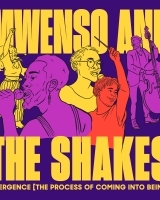Threesomes in the 21st Century

Ménage à trois Gag. Image by Bill Wenzel
The first threesome took place in the Garden of Eden. Do I need to do the math? Adam, Eve, a juicy apple; a serpentine form popping up at just the right moment; a “come on, you’ll like it once we get going” enticement; some frankly slopping eating skills; and, once the whole thing’s over, the breaking loose of all hell, quite literally. Isn’t that the blueprint for every threesome hence?
Take that line of questioning to its conclusion, in fact, and you’ll come, rather aptly, to three realizations. Firstly, that the three-way sex act is as pure and natural a thing as sin itself. Secondly, that apple juice is quite the wrong sort of thing to be putting in our children’s lunchboxes. And thirdly, that the writers of the bible – be they human or celestial – had a working knowledge of just how tricky these things could get.
Try this, from Noel Coward’s A Design for Living: “I love you. You love me. You love Otto. I love Otto. Otto loves you. Otto loves me. There now!” One can barely keep up! Which, incidentally, is a sentence that dear Otto – who’s palindromic name sketches cheerfully his willingness to go both ways (and often at the same time) – is bound to have uttered at some point or other.
Or perhaps not. After all, for seven years the Lord Chamberlain deemed A Design for Living unsuitable for London performance. Coward’s play, however, is not an isolated case, either in content or treatment. Because, for the vast majority of the twentieth century, the threesome lay on the fringes of decency: a play thing for bohemians, for artists, for radicals; a too-close-to-the-bone challenge to monogamy in an era still hungover with Victorian sobriety.
A recent Facebook survey identified Generation Y as the first of its kind to value experiences consistently higher than possessions. Well, what better experience than the threesome?
Here’s what I mean. In his unfinished short story The Garden of Eden, Ernest Hemingway thrashes out the details of a psycho-sexual game of cat, mouse, and, well, another cat in which a writer and his wife enjoy the company of a younger woman on the Cote D’Azur: “Remember, everything is right until it’s wrong. You’ll know when it’s wrong.” says the patriarch to his prey, a sentiment that, even while hymning the naturalness of the three way, acknowledges that there are lines that ought not to be crossed. The Dadaist writer Henri-Pierre Roche, meanwhile, filled diaries with seemingly nothing but consummated love triangles, while in On the Road, Jack Kerouac ignites all sorts of unholy trinities in all sorts of places.
And as it was in art, so it was with artists. Pablo Picasso, Jean Paul Satre, Simone de Beauvoir, Anais Nin, Susan Sontag, D.H Lawrence, George Bernard Shaw, Friedrich Nietzche, Alberto Giacometti: what does this litany of triptych champions give us, aside from the world’s most pretentious imaginary dinner party? The consensus that three is the magic number (I’ll have what they’re having), and the evidence that, for most of that century, the three-way sex act belonged only to those who dared live outside of society.
All that sneaking around in the shadows! And this at a time when, all about it, other sex acts were noisily throwing off their cloaks. The blowjob, as Christopher Hitchens fondly points out, took its opportunity in the 20th century to clamber up from the subterranean gay scene, shrug off the implied disdain of its root “below job”, and jump, joyfully, into first-date territory. This “toothsome treat”, Hitchens says at the essay’s climax, soon identified itself as the “specifically American sex act”, informed, no doubt, by the relative wonders of U.S dentistry. But I’d argue that—somewhere between the film Deep Throat and president Bill Clinton’s vestibule—the blowjob also became the specifically 20th century sex act.

Les Trois Grâces. Artist Unknown, 16th century Flemish school in the style of Allori.
Courtesy the Musée du Louvre.
Which got me thinking: when the historians look back at our jolly 21st century, what will they view as its definitive sexual totem? Well, I’d really like to plead the case (and gosh I’m sure I’ve said this sentence before) for the threesome, if you’ll hear me out.
Here are the facts: In 2004, ABC’s American Sex Survey announced that 14% of men and women aged 18-39 had indulged in a threesome. A joint report by Cosmopolitan and AskMen, meanwhile, pegged the number nearer 10%. By the end of 2013, however, the Metropolitan Report found that as many as 1 in 5 – or 20% – of their international respondents had dipped their toes in that Jacuzzi water.
Such is the rate of uptake, in fact, that “one is probably happening near you right now”, according to Sophia Money Coutts in December’s issue of Tatler. And when the world’s oldest magazine sees fit to put together a piece on threesome etiquette, you know it’s more than just a passing phase. “The key” Sophia writes, “is spontaneity”. Good point. In fact, compare that to the advice offered by Arno Karlen in a 1988 academic paper, and you’ll start to see just how far we’ve come: “a threesome requires not abandon, but the timing and tact of ballet”. Please! In fact, I’d go as far to say that the reason the threesome is enjoying such a healthy renaissance is precisely because it can’t be planned. While a standard sexual tete-a-tete usually requires at least some wining and dining and a touch or two of box ticking, the threesome’s spontaneity makes it both a relief and a prize to a group of young people raised on instant gratification.
I can go deeper on this one. A recent Facebook survey identified Generation Y as the first of its kind to value experiences consistently higher than possessions.
For the vast majority of the twentieth century, the threesome lay on the fringes of decency: a play thing for bohemians, for artists, for radicals; a too-close-to-the-bone challenge to monogamy in an era still hungover with Victorian sobriety.
Well, what better experience than the threesome? And what, while we’re at it, better way to demonstrate your lack of possessiveness? I don’t think I’m going too far, either, when I say that the advent of the Sharing Economy – that immensely potent huddle characterized by Uber and Air BnB – could be pegged neatly to the rise of the altogether more intimate deal. And if economics isn’t your bag, try this: Cara Delevigne, Rita Ora, Rihanna, Angelina Jolie, Drew Barrymore, Amber Heard, Ruby Rose, Lindsay Lohan. Each of these women has identified themselves – out loud and in the last three years – as “flexisexual” or, in other words, as very happy to have their cake and eat it, and often both at once. The stage, as they say, is set.
Need more? GQ and Cosmopolitan magazines both published articles this summer pitching the threesome as a pillar, and possible savior, of a healthy relationship; not as the gateway to cheating, but as the missing piece of an ancient puzzle. In 2009, meanwhile, an episode centering on a threesome quickly became the highest rated in Gossip Girl’s history, despite the fact that Hilary Duff made up 33% of the bargain. Moreover, four of 2015’s best selling “young adult” books feature polyamorous relationships. Tinder estimates that 12% of its users have arranged a threesome via its service (“How do you do? And who’s the friend on the left?”) while 3nder – a London-based copy-cat that seemed destined for app hinterland – received an unexpected $500,000 boost not two weeks ago. The word, friends, is out: Don’t do things by halves; do them by thirds. Don’t have sex with lots of people; have sex with lots of people at once. Bi-curious is so passé: tri-curious is much more the thing. And when the time comes, dear reader, for you to plead your own humble case, simply explain to your doubled audience, calmly and sweetly, that this is not simply about making love: it’s about making history.

